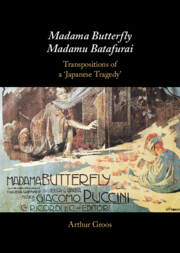Book contents
- Madama Butterfly/Madamu Batafurai
- Madama Butterfly/Madamu Batafurai
- Copyright page
- Dedication
- Contents
- Illustrations
- Musical Examples
- Preface
- Acknowledgments
- Note on the Text
- Abbreviations
- Introduction: “Marriage… in the Japanese Way”
- 1 Loti and Long – with an Eyewitness Account
- 2 Madama Butterfly: A Conflicted Genesis
- 3 Far West/Far East: Luigi Illica’s Libretto
- 4 Madama Butterfly between West and East
- 5 Returns of the Native: Madamu Batafurai in Japan
- 6 Returns of the Native: Imaginative Transpositions
- Brief Epilogue
- Bibliography
- Index (by Tanya Izzard)
2 - Madama Butterfly: A Conflicted Genesis
Published online by Cambridge University Press: 09 February 2023
- Madama Butterfly/Madamu Batafurai
- Madama Butterfly/Madamu Batafurai
- Copyright page
- Dedication
- Contents
- Illustrations
- Musical Examples
- Preface
- Acknowledgments
- Note on the Text
- Abbreviations
- Introduction: “Marriage… in the Japanese Way”
- 1 Loti and Long – with an Eyewitness Account
- 2 Madama Butterfly: A Conflicted Genesis
- 3 Far West/Far East: Luigi Illica’s Libretto
- 4 Madama Butterfly between West and East
- 5 Returns of the Native: Madamu Batafurai in Japan
- 6 Returns of the Native: Imaginative Transpositions
- Brief Epilogue
- Bibliography
- Index (by Tanya Izzard)
Summary
Traces the convoluted genesis of Madama Butterfly, using unpublished archival sources. Illica’s and Giacosa’s construction of the libretto, with input from Puccini and publisher Giulio Ricordi, required reconciling Long’s story and Belasco’s play while also accommodating different approaches to the “Japanese tragedy” in Illica’s anticolonial perspective and Giacosa’s focus on Butterfly’s domestic alienation. Consensus was further complicated by Puccini’s decision to eliminate an entire scene/act set at the American consulate. The dialogic libretto that resulted incorporated much contemporary knowledge of Japan but was also deliberately “orientalized” – Puccini’s setting appropriated Japanese popular melodies as well as Chinese songs from a souvenir music box. Genre ambiguity, especially scenes with Butterfly’s relatives that resembled comic opera, and the libretto-driven score’s impression of musical formlessness contributed to the opera’s catastrophic premiere at La Scala on February 17, 1904, and it arguably remains open-ended even after a successful revision for Brescia a few months later and the publication of a temporary “standard” score in 1907.
Keywords
- Type
- Chapter
- Information
- Madama Butterfly/Madamu BatafuraiTranspositions of a 'Japanese Tragedy', pp. 46 - 86Publisher: Cambridge University PressPrint publication year: 2023



